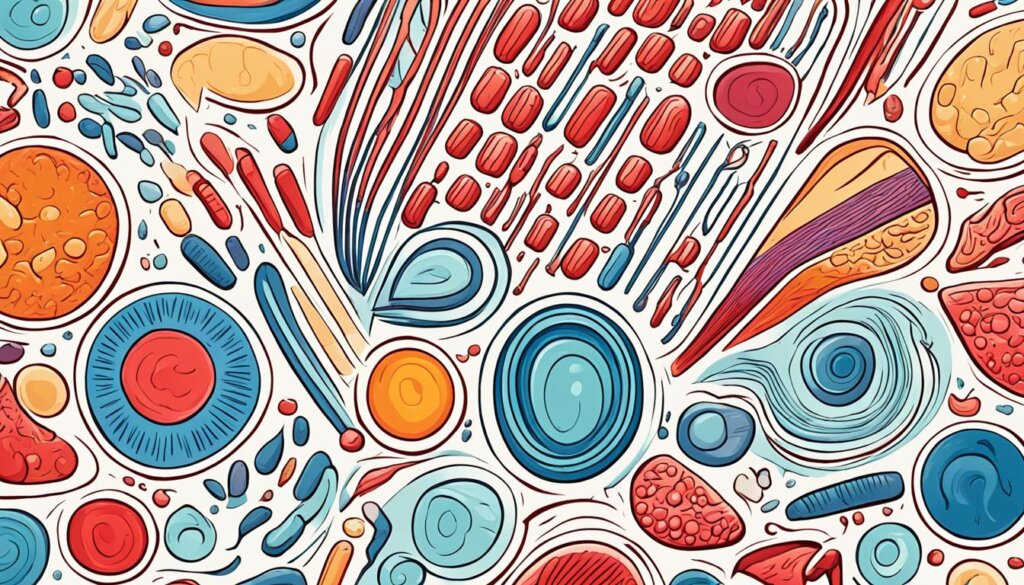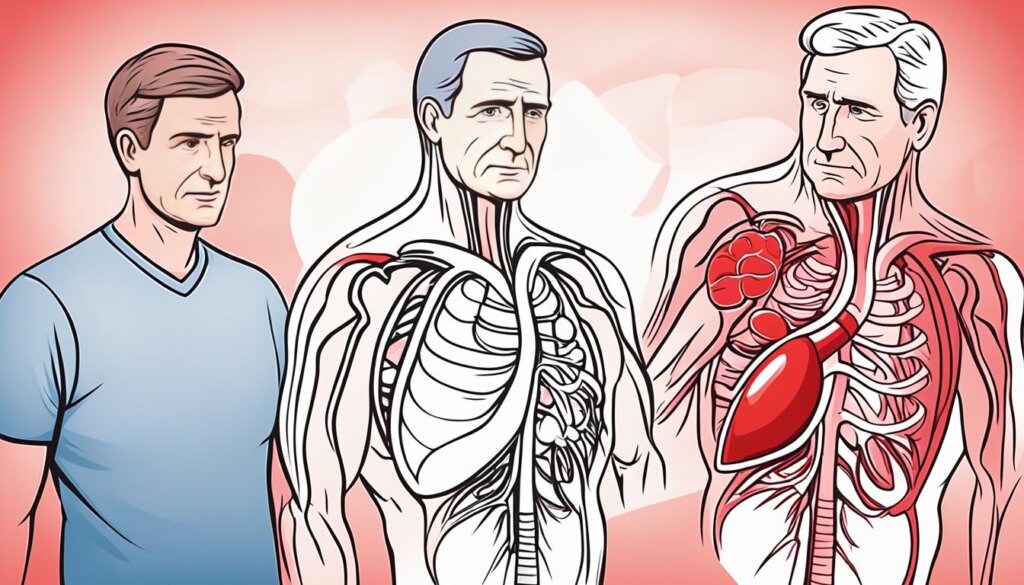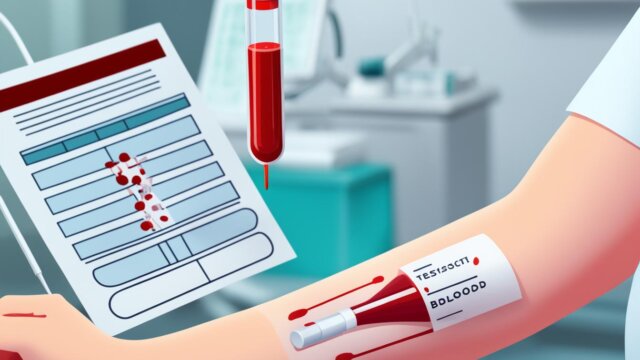FTC disclaimer: This post may contains affiliate links and we will be compensated if you click on a link and make a purchase.
About 10 million Americans deal with angina, a condition where the heart doesn’t get enough blood. It’s important to know the types, causes, and treatments of angina to keep the heart healthy and avoid serious issues like heart attacks.
Angina feels like squeezing or pressure in the chest. It can also happen in the arms, shoulders, neck, jaw, or back. This pain is a sign of coronary artery disease, which happens when these arteries get blocked or narrowed, cutting off oxygen to the heart.
Key Takeaways
- Angina is a type of chest pain caused by reduced blood flow to the heart.
- There are different types of angina, including stable, unstable, variant, and refractory angina.
- Angina can be caused by coronary artery disease, reduced blood flow, and other medical conditions.
- Symptoms of angina include chest pain, discomfort, and other bodily sensations.
- Seeking prompt medical attention is crucial for diagnosing and treating angina.
What is Angina?
Definition and Overview
Angina is a kind of chest pain caused by less blood getting to the heart muscle. It shows there’s a problem with the heart, often from coronary artery disease. People also call it angina pectoris.
Prevalence in the United States
About 10 million people in the U.S. deal with angina. It’s a common sign of heart issues.
Angina warns of heart disease. It’s important to know the difference between stable and heart attack symptoms. While it doesn’t harm the heart like a heart attack, it shows serious heart problems need attention.
Type of Angina | Description |
|---|---|
Stable Angina | The most common form of angina occurs during activity, typically lasting five minutes or less. |
Unstable Angina | Unpredictable, lasting longer than stable angina, and can lead to a heart attack if untreated. |
Variant Angina (Prinzmetal’s Angina) | Caused by arterial spasms, leading to severe cyclic chest pain typically relieved with medication. |
Refractory Angina | A more severe form of angina that is difficult to treat and can significantly impact quality of life. |

Types of Angina
Angina is not just one condition. It covers several types of chest pain and discomfort. Knowing the different types is key for the right diagnosis and treatment.
Stable Angina
The most common type is stable angina. It occurs with physical activity or stress and lasts about 5 minutes. It can be managed with lifestyle changes and medicine for months or years.
Unstable Angina
Unstable angina is the most serious type. It can happen without any activity and doesn’t follow a pattern, worsening over time. It means there’s a high risk of a heart attack, and the pain can last more than 5 minutes.
Variant Angina (Prinzmetal’s Angina)
Variant angina, also known as Prinzmetal’s angina, is rare. It can happen when you’re resting, often at night or early morning. This type is caused by artery spasms and can last over 10 minutes, sometimes more than 30 minutes.
Refractory Angina
Refractory angina is hard to treat and doesn’t respond to standard treatments. People with this type have chest pain that doesn’t go away with usual treatments. It can really affect someone’s life and might need special care.

Angina Type | Characteristics |
|---|---|
Stable Angina | – Most common type – Typically triggered by physical exertion or emotional stress – Lasts around 5 minutes – Can be managed with lifestyle changes and medication – Often occurs for months or years |
Unstable Angina | – Most dangerous form – Can occur without physical exertion – Does not follow a regular pattern – Potential indicator of heart attack risk – Pain lasts longer than 5 minutes – Can worsen over time |
Variant Angina (Prinzmetal’s Angina) | – Rare type of angina – Often develops at rest, frequently around midnight or early morning – Caused by spasms in the coronary arteries – Lasts longer than 10 minutes, sometimes over 30 minutes |
Refractory Angina | – Persistent chest pain or discomfort despite optimal medical treatment – Can significantly impact the quality of life – Requires specialized treatment approaches |
“Angina is a symptom of coronary artery disease (CAD), the most prevalent heart disease.”
Knowing the different types of angina helps doctors give the right treatment for chest pain or discomfort.
Symptoms of Angina
Angina is a sign of coronary artery disease. It shows up as chest pain or discomfort. People often feel pressure, fullness, squeezing, or burning in their chest.
This pain can spread to the arms, neck, jaw, shoulders, or back.
Chest Pain and Discomfort
The main sign of angina is chest pain or discomfort, which can be mild or severe. It usually occurs with physical activity, stress, or when the heart needs more oxygen.
This pain or discomfort doesn’t last long, usually under 5 minutes.
Additional Symptoms
Angina can also cause shortness of breath, feeling tired, and nausea. Women often get a type of angina called Prinzmetal’s angina, which happens at night. Syndrome X, a type of angina without blockages, is also more common in women.
Rest or cardiac medicine like nitroglycerin can ease angina pain. But, see a doctor right away if symptoms change, happen while resting, don’t go away with medicine, last too long, or come on suddenly. Angina can lead to heart attacks, so quick action is key.

Knowing the signs of angina and getting medical help fast can help manage the condition. Eating well, exercising, managing stress, and not smoking can also prevent angina pectoris.
Angina in Women
Angina is a common heart condition that can manifest differently in women than in men. Men often feel chest pain or discomfort, but women might feel pain in the neck, jaw, teeth, or back, or even nausea, shortness of breath, and stabbing pain instead of chest pressure.
This can lead to women waiting longer to get medical help. Up to 50% of women with angina symptoms don’t have a blocked artery. This makes it harder to diagnose. Women are more likely to have microvascular angina caused by small artery problems.
Women with this type of angina face a higher risk of stroke, heart attack, and heart failure than men. Factors like smoking, diabetes, high blood pressure, high cholesterol, and being overweight also raise the risk of microvascular angina.
Women’s coronary arteries are smaller than men’s, adjusted for size. In middle age, women are more likely to have functional heart disease than men, who often have blockages earlier. Women with non-obstructive heart disease and symptoms have a higher chance of future events than men.
Women with recurring angina and “normal” arteries are more likely to have microvascular disease. A family history of heart disease is a big risk for women. Migraines can increase the risk of heart disease and inflammation in women. Women who have preeclampsia or HELLP syndrome are at a higher risk of heart disease.
Inflammation in women in their forties or early fifties can raise the risk of heart problems. Older women often get blockages in their heart arteries, changing the pattern of heart disease. How men and women communicate can affect how angina is recognized in women.

“Understanding the gender differences in angina symptoms is crucial for timely diagnosis and effective treatment of this condition in women.”
When to Seek Medical Attention
Chest pain can be a worrying sign, and knowing when to get help is key. If you have new or unexplained chest pain that lasts more than a few minutes and doesn’t ease with rest or your usual medicine, it might be a heart attack sign. In this situation, call 911 or get someone to drive you to the hospital fast. Quick action is vital to prevent serious issues.
If your chest pain worsens or changes, you should see a doctor. People with heart disease need to watch out closely. Call your healthcare provider immediately if your chest pain worsens or happens with less effort.
Angina means feeling pain, pressure, or other weird feelings in your chest because your heart lacks blood and oxygen. It’s not a heart attack, but it warns of possible heart disease and raises the risk of one. So, it’s crucial to take chest pain seriously and get medical help when needed.
Chest pain can have many causes, such as heart problems, lung issues, muscle strains, or stomach problems. If you have chest pain, it’s best to talk to a healthcare provider to rule out serious conditions and get the right treatment.
Type of Angina | Characteristics |
|---|---|
Stable Angina | It occurs when the heart works hard and needs more oxygen during exercise or stress. The pain can go away with rest and remains stable for at least two months. |
Unstable Angina | A warning sign of a heart attack presents either as new or changed chest pain that is different from usual patterns. Seek immediate medical care for new or worsened chest pain. |
Variant Angina (Prinzmetal’s Angina) | A rare form caused by coronary artery spasms. |
Knowing the different types of angina and when to act fast can help protect your heart health. Getting quick medical help is crucial for managing angina and other heart issues.
Causes of Angina
Angina is a common heart condition caused by coronary artery disease. This happens when the arteries that bring blood and oxygen to the heart get blocked by fatty deposits called plaque. This blockage means less blood reaches the heart muscle, causing chest pain or discomfort.
Coronary Artery Disease
Coronary artery disease is the main cause of angina. When these arteries get blocked, the heart muscle doesn’t get enough oxygen-rich blood, leading to ischemia. Without enough blood flow, people may feel chest pain, discomfort, and other symptoms.
Reduced Blood Flow and Ischemia
Angina can also occur when there is less blood flow and ischemia. Ischemia means the heart muscle doesn’t get enough oxygen, often because the coronary arteries are narrowed or blocked. This can cause chest pain and other symptoms of angina.
Angina comes in different types: stable, unstable, variant, and refractory. Each type has its own causes and needs different treatments.
“Angina is a symptom that indicates reduced blood flow to the heart and can be a sign of coronary heart disease.”
Risk Factors for Angina
Many things can make you more likely to get angina, which is chest pain or discomfort. Knowing these risk factors is key to preventing and managing this heart condition.
- Increasing age: Adults 60 and older face a higher risk of getting angina.
- Family history: Having a family history of heart disease or heart attacks raises your risk of angina.
- Tobacco use: Smoking, chewing tobacco, or being around secondhand smoke can lead to angina.
- Diabetes: Diabetes makes you more likely to have angina.
- High blood pressure: High blood pressure is a risk factor for angina.
- High cholesterol or triglycerides: High levels of these fats in your blood increase your risk of angina.
- Chronic kidney disease, peripheral artery disease, or history of stroke: These conditions also raise your risk of angina.
- Lack of physical activity: Being inactive and being overweight or obese increases your risk of angina.
- Emotional stress and anger: Stress and anger can make you more likely to get angina.
- Certain medications or drug misuse: Some drugs and misusing them can cause angina.
Knowing and dealing with these risk factors can help you prevent angina and lower the risk of heart problems. Regular health check-ups and healthy living are key to managing your risk of angina.
Risk Factor | Increased Risk |
|---|---|
Age (over 45 in men, over 55 in women) | High Risk |
Diabetes | Medium Risk |
Family History of Heart Disease | Medium Risk |
High Blood Cholesterol and Triglycerides | High Risk |
High Blood Pressure (Hypertension) | Low Risk |
Obesity and Lack of Exercise | High Risk |
Smoking | High Risk |
Stress | Medium Risk |
Understanding and tackling these risk factors can prevent angina and lower the risk of heart problems.
“Identifying and managing risk factors is crucial for preventing angina and promoting cardiovascular health.”
Complications of Angina
Angina can be a manageable condition for many, but it’s serious. The biggest risk is getting a heart attack, also known as a myocardial infarction. If not treated, angina can turn into a heart attack, causing permanent heart muscle damage. Knowing the warning signs of a heart attack is key to saving lives.
Recognizing the Warning Signs of a Heart Attack
The symptoms of a heart attack vary, but common signs include:
- Persistent chest pain or pressure
- Pain radiating to the shoulder, arm, back, neck, or jaw
- Fainting or lightheadedness
- Nausea and vomiting
- Shortness of breath
- Excessive sweating
If you or someone you know has these symptoms, get emergency help right away. A heart attack can badly damage the heart muscle if not treated quickly. Don’t ignore these signs; act fast and get medical help.
Angina is a serious condition, but with the right care, the risk of a heart attack can drop. Knowing the warning signs and getting medical help when needed helps protect your heart health. This way, people with angina can reduce the risk of serious complications.
Preventing Angina
Angina is a condition that causes chest pain or discomfort. You can prevent it by making lifestyle changes. Focusing on your heart health can lower the risk of angina.
Prioritizing a Heart-Healthy Lifestyle
Quitting smoking is a key step to prevent heart problems like angina. Smoking is a major cause of death in the U.S. Quitting can save your heart. Eating a diet full of fruits, veggies, whole grains, and lean proteins also helps prevent heart disease and angina.
Exercise is key to preventing angina. Try to do at least 30 minutes of physical activity five times a week. This can lower blood pressure, increase good cholesterol, and control blood sugar, all good for your heart. Managing diabetes, high blood pressure, and high cholesterol with medicine and lifestyle changes can also lower your risk of angina.
Stress can lead to heart disease and angina. It’s important to find ways to manage stress for your heart health.
By making these lifestyle changes, you can prevent angina and keep your heart healthy. Remember, your heart’s health is up to you. These changes can greatly improve your heart health.
Diagnosing Angina
Getting a correct diagnosis of angina is key to making a good treatment plan. Doctors use physical exams, looking at your medical history, and doing tests to determine what’s causing it and how bad it is.
The electrocardiogram (ECG or EKG) is a common test. It checks for heart rhythm problems and signs of less blood flow to the heart. About 75% of angina cases are found with this test.
Doctors might also perform stress tests to observe how the heart acts under exercise conditions. These tests can be improved by imaging, such as nuclear stress tests, which show blood flow in arteries.
A coronary angiogram, a procedure that uses X-rays to show the heart’s blood vessels, might be suggested for a closer look. It can find blockages that might need a stent.
Other tests, such as blood tests, chest X-rays, and cardiac imaging scans, might also be used to check for other causes of chest pain and discomfort.
By combining these tests, doctors can determine what’s causing angina and make a treatment plan just for you.
Treating Angina
Angina is a sign of heart disease that can be managed with medicines and sometimes surgery. The goal is to improve blood flow to the heart, ease the heart’s work, and stop more problems.
Medications
Doctors often use nitrates, beta-blockers, calcium channel blockers, and antiplatelet drugs for angina. Nitrates like glyceryl trinitrate relax and widen blood vessels, helping blood reach the heart. Beta-blockers and calcium channel blockers lower blood pressure and heart rate, making the heart work less hard. Antiplatelet drugs, such as aspirin, stop blood clots that can block blood flow.
Procedures and Surgeries
If medicines don’t help, doctors might suggest procedures or surgery to improve blood flow to the heart. Coronary angioplasty, with or without a stent, and coronary artery bypass graft (CABG) surgery are common treatments. These methods aim to open blocked arteries, boosting blood supply to the heart muscle.
Cardiac rehab, which includes exercise, learning, and changing habits, is also key in managing angina and heart health. For some, treatments like enhanced external counterpulsation (EECP) can help more.
Medication | Mechanism of Action | Evidence |
|---|---|---|
Beta-blockers | Reduce blood pressure and heart rate, decreasing the heart’s workload |
|
Nitrates | Dilate blood vessels, improving blood flow to the heart |
|
Calcium channel blockers | Lower blood pressure and heart rate, reducing the heart’s workload |
|
Ranolazine | Improves heart muscle relaxation without impacting blood pressure or heart rate |
|
“The key to managing angina is to find the right combination of medications and, if necessary, procedures that work best for each individual patient. A personalized approach is crucial for optimizing outcomes and improving quality of life.”
Living with Angina
Angina is a condition that can be managed, allowing people to live well. Making lifestyle changes is key. It’s important to adjust daily activities to handle symptoms effectively.
Pacing your physical activities is crucial to avoid overdoing them, which can lead to angina. Avoiding triggers like cold weather or heavy meals also helps reduce discomfort. Stress management, like relaxation exercises, can help with the emotional side of the condition.
Working with healthcare providers to create a personalized plan is vital for managing angina. This plan might include medications like nitroglycerin and lifestyle changes suited to your needs.
Embracing a Healthier Lifestyle
Quitting smoking is a top priority for a healthier life and to prevent heart disease. Eating lots of fruits and veggies, choosing fish for meals, and eating foods high in fiber are good habits. It’s also important to eat less salt and sugar.
Regular exercise helps control blood sugar, blood pressure, and cholesterol levels. It also keeps weight in check and lowers stress. Aim for at least 40 minutes of aerobic exercise daily, 3 to 4 times a week.
Changing your lifestyle, such as quitting smoking, eating better, exercising, and managing stress, is crucial for managing angina and preventing heart disease. By living healthier, people with angina can improve their well-being and future health.
“After my triple heart bypass at 33, I knew I had to make some major changes. Quitting smoking, adopting a heart-healthy diet, and getting regular exercise have been game-changers in managing my angina and keeping me healthy.”
– Jonathan, angina patient
Angina Research
Research into angina is key to better treatments for those with the condition. Scientists are working hard to turn new findings into better treatments for angina patients. They’re looking at new medicines, improving medical procedures, and understanding what causes angina and heart diseases.
Between 1990 and 2019, diseases and injuries affected people worldwide. The European Society of Cardiology released guidelines in 2019 for chronic coronary syndromes. A 2021 study looked at treating stable angina. These studies help lead to better treatments for angina.
Lifestyle changes are also important for managing angina. Eating the Mediterranean diet has health benefits, and being active can help people with coronary heart disease live longer. Researchers are studying how different treatments work for stable coronary disease and the best ways to treat it.
As research on angina advances, turning discoveries into real treatments is key. Using new advances in heart medicine, doctors can give patients better care. This can greatly improve the lives of people with angina.
Conclusion
Angina is a common sign of serious heart disease, often linked to coronary artery disease. It is vital to know the types of angina, its symptoms, causes, and risk factors. This knowledge helps in getting quick medical help and managing the condition effectively.
By changing your lifestyle, following your doctor’s advice, and sometimes getting medical procedures, many people with angina can live better lives. They can also lower the risk of serious issues like a heart attack.
Key points about angina include that it shows heart disease and can be managed with lifestyle changes, medicines, and sometimes surgery. More research is needed to find new and better treatments for angina.
Studies mentioned in the references give us deep insights into angina’s prevalence, diagnosis, and treatment. They help us better understand this heart condition. By being informed and active, you can take steps to manage angina and keep your heart healthy.
FAQ
What is angina?
Angina is a type of chest pain or discomfort. It happens when the heart doesn’t get enough blood. This is often due to coronary artery disease.
How common is angina in the United States?
In the U.S., about 10 million people have angina.
What are the different types of angina?
Angina comes in several types: stable, unstable, variant (Prinzmetal’s), and refractory.
What are the typical symptoms of angina?
Angina often causes chest pain or discomfort. This can feel like pressure, fullness, squeezing, or burning. It might spread to the arms, neck, jaw, shoulders, or back.
How do the symptoms of angina differ in women compared to men?
Women with angina might not have the typical chest pain. They could feel neck, jaw, teeth, or back discomfort. They might also have nausea, shortness of breath, or stabbing pain.
When should you seek medical attention for chest pain or discomfort?
If chest pain lasts over a few minutes and doesn’t go away, get help. This could mean a heart attack or a serious situation. Always seek help for new or strange chest pain.
What are the main causes of angina?
Coronary artery disease (CAD) is the main cause of angina. It occurs when plaque blocks the arteries that supply the heart with blood.
What are the risk factors for developing angina?
Risk factors include age, family heart disease history, smoking, diabetes, high blood pressure, high cholesterol, kidney disease, lack of exercise, obesity, and stress.
What are the potential complications of angina?
A heart attack is a serious risk. Signs include ongoing chest pain, shoulder, arm, back, neck, or jaw pain, fainting, nausea, shortness of breath, and sweating.
How can you prevent angina?
Prevent angina by changing your lifestyle. Quit smoking, eat well, keep a healthy weight, manage health conditions, and reduce stress.
How is angina diagnosed?
Doctors use a physical exam, medical history, and tests like an ECG, stress test, coronary angiogram, or cardiac imaging to diagnose angina.
What are the treatment options for angina?
Treatment includes medication and sometimes surgery. Medicines like nitrates, beta-blockers, calcium channel blockers, and antiplatelet drugs are used.
How can individuals with angina manage their condition and improve their quality of life?
People with angina can improve their lives by changing their lifestyles. This includes managing physical activity, avoiding triggers, and using stress management techniques, along with their treatment plan.
What is the current state of research into angina and its treatment?
Research is ongoing to better understand and treat angina. Scientists aim to find new ways to help people with this condition.








